Sand fruit is a rather peculiar fruit, it looks not only like an apple.
But also a bit like hawthorn, with a more delicate taste, higher moisture content and sweet taste.
Sand fruit has requirements for the environment.
1.Plot selection
Plot selection is very important, planting sand fruit to choose convenient transportation, good irrigation conditions, generally built on gentle slopes, deep soil, more fertile soil, slightly saline land, leeward and sunny plots.
2.Seedling selection
Requires seedlings 80-120cm high, well-developed root system, no damage to the quality of strong seedlings without pests and diseases, and also has to have a quarantine certificate; requires seedling roots have more than 4 lateral roots.
The daily length of more than 15cm, and requires uniform distribution of seedlings.
Seedlings must have more than 8 strong buds on the cadre position, which is conducive to the seedlings can send good branches after cadre, to ensure the survival of grafting.
While checking whether the seedlings There are autumn tips, generally smooth surface, less hairy, without autumn tips of fruit tree seedlings, the stronger the ability to resist cold.
If the seedlings crumpled skin dehydration, should be eliminated in time, choose to select fresh skin color of fruit tree seedlings.
3.Planting density
Planting density according to the size of the tree to determine, tall canopy per mu of land planted about 44, fruit trees and crops can be planted with a wide row of narrow plants, planting density of 2 × 8 m and 2.5 × 6 m.
Dwarf canopy using 2 × 4 m row spacing, planted 83 plants per mu of land, fruit and grain intercropping using 2 × 6 m, of course, can also be used 3 × 2 m row spacing, planted 111 plants per mu, or 3 × 4 The number of plants planted per acre is about 56 plants.
4.Pollination tree configuration
Pollination trees should be selected to suit the local environment, good varieties, high fruit-bearing rate, can enter the flowering period at the same time with the main plant species with a certain economic value.
Generally every 3-4 rows of the main plant species configuration of a pollination tree, planting ratio of 2:1.
Sand fruit is rich in nutrition, it contains protein and fat and a large number of carbohydrates.
In addition to crude fiber and carotene and vitamins and other substances are also the most important presence in the sand fruit, in addition, niacin, bile and calories and a variety of minerals are also the most important nutrients in the sand fruit.
Usually people eat sand fruit can absorb a variety of different nutrients, but also to promote the body's metabolism, improve the quality of the human body.
In the purchase of sand fruit do not blindly buy, which is a skill.
1.See whether the color is uniform and shiny
Pick any fruit preferred to have to observe the appearance of color, sand fruit can not choose the color is too dark or too light.
The color is too shallow sand fruit is not mature, eat very bitter.
The color is too dark sand fruit is likely to be artificially ripened, and it is not healthy to eat.
Generally speaking, the natural ripe sand fruit color is uniform, the sunlight exposure has a very obvious gloss, if there is no luster recommended not to buy.
2.See whether the surface is free of damage and wrinkles
In addition to looking at the color of the sand fruit, but also observe the surface of the sand fruit whether there is no damage, insect eyes, wrinkles and other phenomena.
If there are insect eyes on the surface, it means that the sand fruit is likely to be insects inside, eating is very affect the taste.
Damage is caused by bumping in the transportation process, it is best not to buy.
There are wrinkles indicate that the sand fruit has been placed for too long, the moisture inside has been lost.
Choose the surface of the sand fruit without damage and wrinkles, so eat not only delicious and very fresh.





